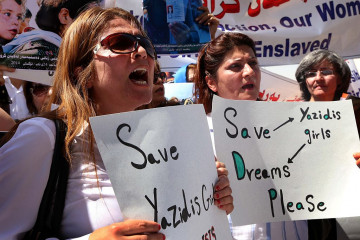

For seven years now, the Islamic State (IS) group's forced displacement of the Yazidis has severely impacted the community's religious and cultural identity, with people from the religious minority now dispersed across the world.
The Yazidis are a minority sect, living mostly in Sinjar northeast Iraq. They have experienced repeated genocide campaigns throughout their history of 5,000-7,000 years. Prior to IS attacks, according to the International Organization for Migration (IOM), their population stood at 550,000 in Iraq, but hundreds migrated abroad and were displaced in different spots in Kurdistan and the Sinjar mountain.
According to the office of the Rescued Yazidi Abductees, 360,000 Yezidi have been displaced to Kurdistan and Sinjar mountains, with a further 120,000 migrating to Europe, with countries such as Germany, France, Netherlands, the USA, Canada, and Australia being the main destinations. Furthermore, according to IOM's latest statistics, 200,000 remain displaced in 16 different IDPs (Internally Displaced Persons) regions in Kurdistan/Northern Iraq, mostly in the Dohuk governorate.
While their forced displacement has provided a unique opportunity for Yazidis to interact with new cultures and communities, it has also brought severely negative effects that have significantly threatened the Yazidi identity inside and outside of Iraq. This is a result of living with their host communities, adjusting to their cultural and social habits and practices.
“As Yazidi children, we grew up in a different environments and were exposed to different cultures [in displacement], we've forgotten about our geography, particularly Sinjar. We now only hear about Sinjar in negative ways – IS attacks, kidnapping, genocide, killing. All these things give them [the children] a negative view on their homeland and consequently, they forget about their identity," said Zozan Hassan, a displaced Yazidi in Kurdistan.
"As a result of so many years of displacement, Yazidi children have started to forget their Kurmanji language and mix it with other languages, and this has had a huge impact on their identity."
The minority group do not have textbooks and archival records in their language, with many now not knowing how to read and write in Kurmanji.
The Yazidi religious identity is also facing the risks of elimination after displacement; according to the office of Rescued Yazidi Abductees, 68 temples and shrines were demolished in Sinjar by the extremist group in 2014.
“As a result of that destruction, we have started to neglect religious rituals and practices, while many of us also forgetting about these practices since they are no longer living in Sinjar,” Said Ronny Saeed, a Yazidi woman displaced in Kurdistan.
|
The displacement, however, has also brought about some positive changes in the community, such as new interactions with other communities and allowing them to open up, adapt, and communicate with new cultures.
A Yazidi man from Sinjar, who preferred not to disclose his name said, “Living in a new environment gave an opportunity to the Yazidis to realise and recognise their rights as a minority. They have started to raise their voices and ask for their rights like any other Iraqi citizen who has been marginalised and silenced for so many decades due to their religious beliefs.”
Ghazala Jango is a Yazidi researcher from Sinjar in north-eastern Iraq, currently completing her journalism degree at the American University of Sulaimani.




 Follow the Middle East's top stories in English at The New Arab on Google News
Follow the Middle East's top stories in English at The New Arab on Google News


